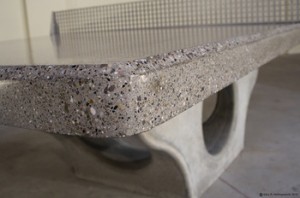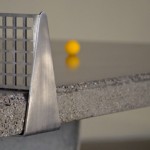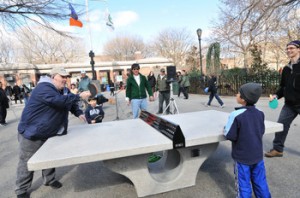Table Tennis Moves to the Urban Outdoors
Welcome to the HENGE table.
By Alan Good, Owner HENGE Tables
Here in New York City there’s a park which is on a growing list of public outdoor spaces in the US that has a permanent outdoor table. The location of the table is dead center in the 10 acre Tompkins Square Park, right next to the fifth most popular dog run in the country, and at the crossroads of people’s routes to and from stores, home, school, work.

Model T40 Henge table, Tompkins Square Park, NY
The table arrived in March, and I started watching passersbys and players for their reactions. The first thing I saw was astonishment. Some people didn’t believe the City would keep the table. Manhattan is a crowded island, and many large installations of art stick around for six weeks then disappear. A Latino man with 8 year old son at his side turned to me with a strange sound in his voice—skepticism mixed with longing. He didn’t permit himself hope that the table would stay. “When are they taking this down?”he asked. “It’s permanent,” I answered. You could see him try to hold back his own excitement, and start to let it out.
This summer my company wanted people to see the new table in action, so we shortened the distance to the equipment. We left free paddles and balls in the sculptured cave under the table. We wanted folks to grab and play as soon as they saw the table. I wrote “Let Me Play and Stay” on the rubbers. After the first day, gone—the paddles disappeared. I brought two more; they lasted three days. By the end of the second week the paddles were sticking around—no more disappearances. They’re $2 imports, so their death comes early. About the lack of theft everyone is dumbfounded—from the homeless to the parks staff to the police to the residents. This is the town where people padlock potted plants.
Now people play the table from 7 am past midnight.
The regular players dubbed some shots “ninja balls”. These players show up at the table five nights a week, learn each others’ styles and then each others’ names. While waiting they make up a table tennis folklore and set of customs. It’s considered etiquette for waiters to retrieve balls for players. When a shot flies past and hits the grainy asphalt, the chaser galumphs after them sometimes twenty yards; the balls hopping every which way as if to elude capture. Hence the term Ninja ball—a ball with a mind its own, skilled in all combat styles, including evasion. Some balls get flattened in pursuit.
Over the months I’ve stopped by almost daily to watch the action. After dawn many of the park users are older Chinese doing stretching exercises. A pair of them are playing table tennis by eight. There’s a Swedish mom with two 9 year old boys, all on bikes, who arrive packing their own paddles. A dad with his three year old son in a stroller slows to a stop. Both fall silent, and for a few minutes the dad glows and smiles, lost in watching the ball play—he seems to have forgotten the boy, who’s also watching but with a more critical gaze.
A five foot fence runs past the table, and the regulars hang out, leaning against it, talking, waiting their turn. One week someone left a box of chalk next to the pile of paddles and people waiting staked their place by writing names on the asphalt.
By common consensus all games go to 21.

Polished concrete top is smooth to the touch.
A locust tree arches overhead, providing some shade, but there are four street lights that give just enough light to play with. People prefer orange balls after dark—the white balls don’t contrast well with the concrete surface. Many mistake the table’s material for marble or granite because we grind off the concrete “cream” that naturally rises when the concrete first pours into the mold. Lying just under this one millimeter layer are the pebbles that give cement its strength and turn it to concrete. When we grind and polish through these the surface becomes smooth to the touch and also multi-colored—pebbles have different hues and brightness.
How does the surface play? Perhaps more lively than the composite indoor tables. But a ball definitely comes up the ITTF requisite 23 cm when dropped from 30 cm.
People are still downright surprised when they encounter the table—it’s massive and the base has a strange and some think beautiful shape. When you touch it or lean on it, you detect that it is not going anywhere—it’s heavy and very much there. There is no budge. Like chopping broccoli on a professional butcher’s block, the surface doesn’t vibrate or even make much of a sound.

Stainless steel net is optional
Playing outdoors has its own advantages, and few player complain that they’re not getting the controlled indoor conditions of proper floor, lighting and a regulation textile net (the Tompkins table has a metal net that lacks the 6 inch overhang). Surprise and joy seem to accompany many visitors’ first time approaching the table. Many want to see what the play feels like—“how does the ball bounce?” is the second most common question. Almost everyone adapts within seconds, sensing a normal volley taking shape, and are hard pressed to distinguish ball play from the indoor models. Also, there’s a bit of humor in the table—it’s very accessible, right on a pedestrian thoroughfare, but by the same token it is public—the public sees you play. There’s a wide circle of people who pause to watch the play, chat and gossip who seem quite happy just to watch. So inevitably the table starts to resemble a pub—passersby slow to a crawl and start a hang out. I’ve seen thirty people watching on weekends.
But is it table tennis?
If you happen to be the one at the table, you might find yourself facing a friend or stranger, with a light crosswind blowing and the sun shining, or not,

Henge table play during March 2011 dedication.
with people passing by and the dogs baying next door, perhaps a twig or two on the table from the lotus tree overhead. These are not tournament conditions. But there is another level to the joy that many people show in their faces as they see the table for the first time. The game has come
outdoors. Hundreds of people per day see the play. Thousands per week. Ok, it’s beginners and intermediates knocking around. But whether watching or playing, no one fails to notice the faces and body language; the feelings, the groans and yelps, the laughs, the downright genius and fun of a beloved game.
Thus rises the profile of a game and a sport.



